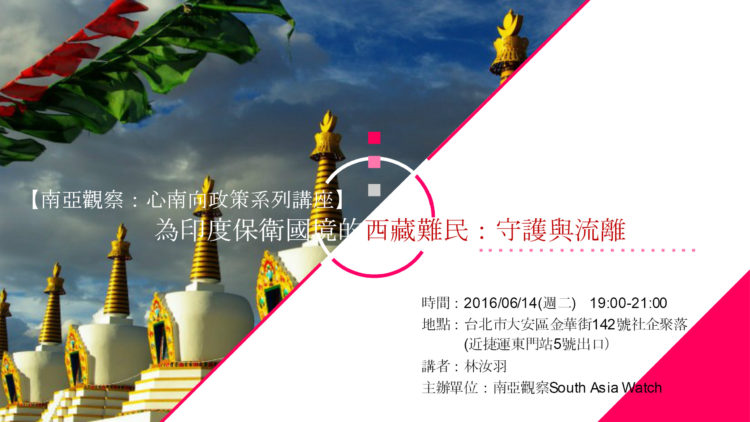
呼應新南向政策的崛起,對於南亞的關注刻不容緩,然而除了要有新,也必須用心理解南亞。南亞觀察網站長期分享南亞議題與相關文章,是華文地區資料最完善多元的南亞資料庫,現在更跨出單純網路經營的方式,舉辦【南亞觀察:心南向政策系列講座】,將南亞的不同面相介紹給大家。
第一場將由長期旅居南亞的研究者林汝羽,分享對於印度流亡藏人相關的研究。這份演講主要分享在印度流亡藏人社群當中,針對已退役的年長藏人早年在印度軍隊服役中的經驗,所發現的故事。從六零年代至今,有許多藏人在印度軍隊當中服役,但這個特殊的群體鮮為人知。他們當中從軍動機各異、流亡的故事也不盡相同。除了分享藏人在印度從軍的歷史,也將探討早年流亡印度的藏人個人意義結構上,國族敘事與情感的轉向。無論是關注印度、流亡藏人或是無國籍難民的議題,都相當推薦來參加這場絕無僅有的講座!
#活動臉書頁面
https://www.facebook.com/events/1623117641339558/
#購票網址
http://www.accupass.com/event/register/1605300830381812069544
Narratives of Tibetans Defending Indian Borders
After 1959, the Tibetan guerrillas who fought against Chinese invasion, later facilitated the 14th Dalai Lama’s escape through the Himalayas, have joined the Indian army in the early 1960s. The Special Frontier Forces(SFF) based near Dehra Dun in Uttar Pradesh, also known as Establishment 22, recruited many Tibetans who have came from Tibet in a time span from 1959 to early 1970s. The former guerrillas served in the Indian army with the expectation of defeating the Chinese, regaining the military strength of Tibet, and then prepare to return to Tibet. Such scheme has changed after 1962 Sino-Indian war. Since early 1980s, the reason of the second-generation Tibetan refugees joining the Indian army, is mostly economic, and such has become a survival strategy for refugees.
These trained soldiers brought a stable income to their family to support basic education for their siblings, wedding and funeral expenses, and initial financial endowment of seasonal sweater selling business. They often engaged in business or farming after retirement, some of them continue serving at the security department of CTA. This paper wishes to share the preliminary findings in the fieldwork, to depict the trajectory of two generations defending the border of where they don’t belong, and some of them participated in wars.
Furthermore, this paper wishes to elaborate the meaning of the state for these refugees from their experiences serving in the army, for example, how does the concept of the Indian state link with the idea of a “Tibetan state”? Does their body experiences reflect on their knowledge of self and thus make them different from other refugees? Nowadays in Ladakh, Tibetan teenage boys who grew up in a hybrid culture, choose to leave their school education at the age of 14 to 15 and join the Special Indo-Tibet Forces. Is this trend different from the former pattern? Are their experiences different from the previous generation? Or it shows the diversified conditions of Tibetan refugees’ livelihood in various environments?
Tibetans are the people who crossed the border, grew nearby the border and defended the border; their narratives shed light on the meaning of territorization in our times.
